- Article tells about the deep connect between the Saivas of Tamil Nadu, Bengal and Central India in earlier times and their influence including on temple architecture.
A few months back,
there was a hashtag on Twitter #TamilsAreNotHindus and people uninformed and
untrained in rigours of logic came up with all kinds of fancied explanation
about the Cholas being followers of Native Shaivam. Many experts answered such
malicious and unaccounted claims from different perspectives. This article adds
weight to the factual rebuttals.
In Kamikagama, one
amongst the twenty eight Mulagamas of
Shaiva canonical literature, whose tenets are followed even currently in most
of the Shiva Temples in Tamil Nadu, we come across a very peculiar reference-
tadurdhvaṃ
gauḍabhaṣadyair-ganaṃ dhupantam acaret |
urdhvaṃ
draviḍabhaṣaṅkaṃ ganaṃ nṛttayutaṃ tuva ||(KA.Purvabhaga 6.437c-438b)
Translation: ‘Thereafter (the singer) should engage in singing in the Gauḍa or (related) languages until the burning of incense is finished, or sing in the Draviḍa language, together with dancing.’
The practice of singing Tamil devotional songs in the Siva temples as a regular part of worship, which continues to the present day by the ‘Oduvars’ (tiruppatiyam paṭuvar), finds its first epigraphical attestation in an inscription of the Pallava Nandivarman III of 863 CE at the Bilvanathesvara temple of Tiruvallam.
But
the prescription of song in Gauḍabhaṣa or Bengali in temples in Tamil Nadu implies
a deep connect that the two regions had.
On further
inspection, one can see that there were many Shaivacharyas from Vanga and
Madhyadesha who have had deep impact on the religious life of the Tamil
region.
Enquiring further
we find that there are other earlier references to Bengal for e.g. Saint
Thirunavukkarasar (Appar) mentions a temple called Mahasthana, which is in
modern Bangladesh. Saint-poet Thirugnanasambandar, who is considered to be
verily the son of Lord Shiva by the devout, mentions about the Brahmins from
the Gangetic delta, who had settled in Sirkali, near Chidambaram.
Upon historical
scrutiny, we find the Shaivacharyas from the region of Gauda and Malwa region
served as the Rajagurus of many great Chola emperors, throughout the Chola
rule. Isanashiva and Sarvashiva are mentioned in inscriptions of Rajaraja I
(985-1014 CE) and Rajendra Chola (1012-1044 CE) as the Gurus who initiated the
kings in Shaivasamaya. We even get to
know that the Shaiva Diksha name of Rajaraja-I was Shivapadashekhara. There is epigraphic evidence to show their
considerable influence in the Chola courts during the periods of Kulottunga I- Kulottunga-III
(1070- 1216 CE).
In the Karma-kriya-kanda
and the Paddhati composed by
Somashambhu, the lineage of Ishanashiva is mentioned. He was succeeded by
Vimalashiva whose disciple was Sarvashiva. It is stated that Rajendra-I
supplied a large quantity of grains as acharyabhoga (gift to one’s teacher) to Sarvashiva and his disciples in the Aryadesha, Madhyadesha and Gaudadesha. Somashambhu was Vimalashiva’s disciple and he had composed several Shaiva works.
Siddhanta-saravali of Trilochanashiva records that
Rajendra Chola saw the best of the Shaivacharyas during his campaign in Bengal,
when he came to take a bath in the Ganga, and he invited them to settle in
Kanchi and elsewhere in the Chola kingdom.
rajendracol̤a ityakhyaḥ col̤abhupo mahiṃ vasan.
gaṃgasnanartham
agatya dṛṣṭva saivanvaran tada.
Snatva
pratinivṛttassan tan samadaya saivakan.
Svarajyasthapayamasa
saivacaryavaraṃstada .
kaṃcimadhye
caul̤abhumau sarvatraiva pravistaraḥ.
One may also
remember that King Bhojadeva, the Paramara king of Malwa, the contemporary and
ally of Rajendra Chola, was himself as great scholar of Shaivasiddhanta and the
author of Tattvaprakashika, Siddhantasarapaddhati
amongst several other texts. Tattvaprakashika is considered to be one of
the eight main texts for study (ashta-prabandhas) which were commented upon by
the polemic Aghora-Shivacharya of Chidambaram.
Vikrama Chola had
Srikathashiva and Kulottunga II had Dhyanashiva also of Gaudadesa as Rajagurus.
Dhyanashiva also wrote commentaries on 28 Mula-agamas.
Inscriptions in Chidambaram tell that Naralokavira, a commander in Vikrama Chola’s army, consecrated images of Sri Gnanasambandar and a ‘Bhattacharya’, arranged for singing the Tevaram verses of Gnanasambandar.
bhaṭṭacarya
iti srutaṃ bhuvi sivaṃmurtisivaṃ yovahan
saṃvadaṃ
kila vedabahyasamayaṅaghatasya cakrepura.
The name
Bhattacharya, suggests a Gauda Shivacharya. We also come to know from the same
reference that Bhattacharya defeated the scholars of other systems to establish
Shaivasiddhanta.
There is also
mention of another Shivacharya by name Umapati Gangoli in a Kanchipuram
inscription dated CE 1172.
According to Dr Nagaswamy,
these references to Gangoli and Bhattaacharya, two popular surnames in use in
Bengal, are the earliest references in inscription, anywhere in India.
We shall see the
significance of Thiruvarur in the process of Shaiva influence later.
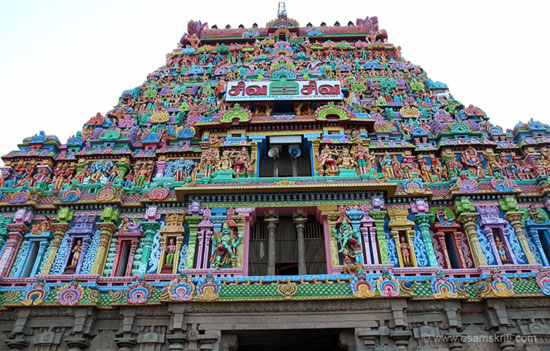 East facing gopuram, TyagarajaswamyMandir, Thiruvarur
East facing gopuram, TyagarajaswamyMandir, Thiruvarur
In the main Gopura
facing east of the Tyagarajaswamy temple at Thiruvarur, considered to be the Adipitha of the Shaivas, there are many koshthas (niches), and in the inner part
on the adhishthnavarga just above the
upapitha, we see two interesting
sculptures. One on the left and the other on the right with inscriptions on the
pitha.
The one on the
left is that of Kulottunga-III depicted with a tied bun, long trimmed beard and
hands folded in respect. While the one on the right depicts a Shaivacharya with
mated locks arranged like a Jatamakuta,
long beard, rudraksha chain around the neck, yajnopavita, wearing a long lower garment with beautiful folds. The
hands of the sculpture is damaged. This is the Someshvara-Shambhu,the guru of
Kulottunga-III.
To
see Thiruvarur temple album
The inscription in
the Kampahareshvara temple at Tribhuvanam, constructed by Kulottunga III, tells
us about Isvara-Shambhu thus-
srikaṇṭhasambhu-tanayedampatirnṛpaṇaṃ
paṇḍyari...
somesvareṇa
guruṇa bhuvanasya pitroḥ
sreṣṭham
akarayatasau sivayoḥ pratiṣṭhaṃ
Translation: The
consecration of the divine couple, Parvati and Parameshvara was effected by Sri
Someshvara, the son of Srikantha, and the preceptor of the enemies of the
Pandyas (Kulottunga-III).
A partially
damaged inscription, below the images, gives us a fair idea about the genius of
the Someshvara Shambhu-
Vidya
yena maniṣina nigadita vispṛṣṭamaṣṭadasam
sthaṇor-yena
viviktamopaniṣadam visvasakatvaṃ ..
vedakara ca saivadarsana-dṛsa siddhantaratnakaro….
We
come to know that Someshvara Shambhu was from Dakshina Radha region of
Gaudadesha and author of the Siddhanta manual by name Siddhantaratnakara.
An inscription
dated 1262 AD in Chidambaram Nataraja temple mentions Dakshina Radha, as place
of origin of Ishvara Shiva thus-
“uttarapatattu takṣiṇaraṭattu kaṅkoli tirucciṟṟampalauṭaiyar aṉa uṭaiyar icuvaracivar”
Translation:
Ishvara-Shiva, who hailed from southern Radha country of the north, served the
Lord of Chidambaram.
Dr Nagaswamy opines that Udayiyar Isvar Shiva mentioned in an inscription in Tribhuvanam temple, built by Kulottunga-III in 1210 AD, was Someshvara Shambhu, the Acharya, to the Kulottunga-III and also Rajaguru to Kulottunga’s successor Rajaraja III.
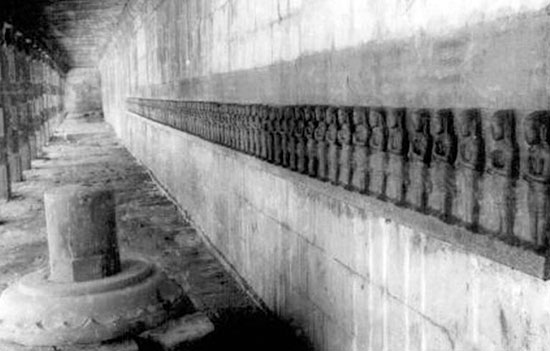 Shivacharyas in Darasuram Temple, Kumbakonam. Pic by author.
Shivacharyas in Darasuram Temple, Kumbakonam. Pic by author.
Interestingly, one
can see the series of more than ninety-five labelled images of Saiddhantika Shivacharyas
in the Iravateshvara temple at Darasuram constructed by Rajaraja III.
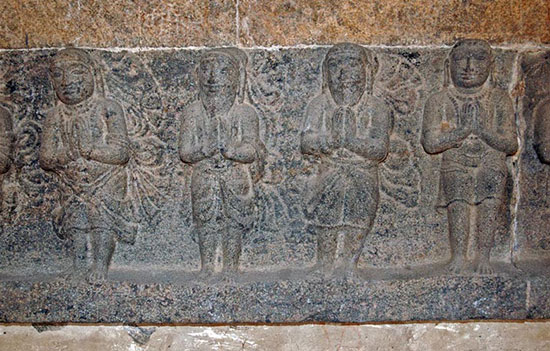 Close up of Shivacharyas in Darasuram Temple, Kumbakonam. Pic by author.
Close up of Shivacharyas in Darasuram Temple, Kumbakonam. Pic by author.
To
see album of Darasurammandir
Another
important aspect to be looked into while studying the cross-geographical
influence in the spread of Shaivasiddhanta is the textual tradition.
Shaiva texts can
be classified broadly under Core texts which were the Mula Agamas and Upagamas, Commentaries
on these Agamas and Compendiums or paddhatisgranthas.
On one hand we
have the Kashmiri Abhinavagupt Acharya calling Gurjaradeshiya Lakulisha and Madhyadeshiya Srikantha as the two sole authorities on
Shaivism.
Whilst on the
other we have the Srikaṇṭhabhaṣya, a Saiva
commentary on the Brahmasutra composed by Nilakaṇṭha, also called Shrikantha
from Dakshinadesha expounding a Vedantic Shaiva non-dualism in which Siva is
qualified by his power of consciousness (cicchaktivisiṣṭasivadvaitam),
in keeping with Vedantic orthodoxy, to be both the efficient and the material
cause of the world. He draws not only from the usual Vedic sources for this
purpose but also on the works of the Kashmiri Shakta Shaivas, quoting the Isvarapratyabhijnakarika of Utpaladeva
and the Bodhapancadasika and Tantraloka of Abhinavagupta.
Aghora Shivacharya,
a profound scholar who was active in Chidambaram around the middle of the
twelfth century, perpetuated the Siddhanta tradition of Kashmiri Bhatta
Narayanakantha and Bhatta Ramakantha apart from composing his commentaries on
the various other texts.
During the period
under discussion, the Shaiva Siddhanta was
very active and vibrant in Madhyadesha, with established centers such as
Amardaka (Aundah in the Marathwada region of Maharashtra), Golaki (Gurgi, Madhya
Pradesh), Radha (West Bengal), Gopakshetra (Gwalior, MP), Kadambaguha (Chambal,
MP), Somapuri (Bangladesh), etc. apart from Varanasi.
There was a constant movement of scholars between the regions for study and sharing the doctrine.
Here are two
instances. In Balabodhini, a
commentary on select portions of Kiraṇagama, in a single South-Indian
manuscript, the author identifies himself in the colophon as Siṃharaja, son of
Kamarupesa and pupil of Nilakaṇṭha, the pupil of a pupil of a Guru at
Amardakapura, This indicates the travel of students from the south to be in the
presence of Shaivacharyas from Amardaka was in vogue.
In Jnanaratnavali of Gnanashiva, a
contemporary of Aghora Shivacharya, we find explicit mention of him being
originally from Chidambaram but living in Banaras when he wrote this work. He
tells us that he, though residing in Varanasi, is a devotee of the Lord of the Dabhrasabha i.e. Nataraja in Chidambaram,
indicating his southern origin.
Srimad
dabhrasabhesvar-anghri-kamala-dvandva-lina-dhimata |
Srimad-vijnanasivena
vedaviduṣa varaṇasivasina | |
Golaki Matha, a
Saiddhantika monastery at Golagi (Gurgi), about 12 miles to the east of Rewa,
(Madhya Pradesh- a town in the north of the Kalacuri kingdom) was the site of
once vast Saiva monasteries and temples and the stronghold of Shaiva schools
which produced some brilliant Acharyas whose contributions were recognised by
most of the rulers during the medieval period.
Many had even
dedicated their kingdoms at the feet of these Shaivacharyas. The Kriyakaṇḍa-kramavali written by Somashambhu, the mathadhisha of Golaki, composed in1048 CE is most popular and used in most Shaiva temples in Tamil Nadu till date.
See album of Siddhanath
Temple, Omkareshwar Island in MP
Saiddhantikas were
invited by rulers from all parts of Bharatavarsha for the propagation of the
Saiddhantika tradition. Their activities in Tamil Nadu too were a result of
such an invitation by the ruling monarchs. Centres of Golakimatha were
established in Tiruvarur and Thiruvenkadu.
Study of the Naṭarajapaddhati composed by Ramanatha of the ‘Southern Golaki Matha’ founded at Tiruvarur, throws more light on the origins of the institution. That Ramanatha himself was attached to the Tiruvarur branch of Golaki is clear from the textual reference where he says-
goḷakimaṭhaniṣṭhana …. vidhayinim |
paddhatim
naṭarajakhyam akarot sukhabodhitam | |
Translation: The
Guru of the Golokimatha has composed this Naṭarajapaddhati
in the Saka year 980 to guide the practice of the ascetics of the Golaki
monastery.
In the concluding verses, Ramanatha tells us, that the establishment in Tiruvarur (Kamalapuri/Kamalalaya), was known as ‘the Southern Golaki Matha’, having been founded by Brahmashiva, a resident of Gudadesha and a Shaivacharya from the main Golakimaṭha far to the north:
teṣveko
gauḍadesiyaḥ praptavan kamalalayam |
idṛsiṃ
murtimadaya dakṣiṇatyottitirṣaya ||
siva
evayamiti lokanumoditaḥ |
pada-vakya-pramaṇajnaḥ
sriman brahmasivaḥ ||
tatra
puṣkariṇi-tire dakṣiṇe golagimaṭhe |
vidvadbhiravasat sarddham agnikalpais-tapodhanaiḥ …
Translation: ‘Among those Acharyas of the Golakimaṭha was the venerable Brahmashiva, a native of the Gauḍa region, learned in grammar, hermeneutics, and epistemology, who came to Tiruvarur and lived amongst the resplendent learned ascetics and established the Southern Golakimaṭha on the bank of the Pushkarini (Kamalalayam tank), applauded by the people as Siva himself who had come to them after assuming this form in order to rescue the them.
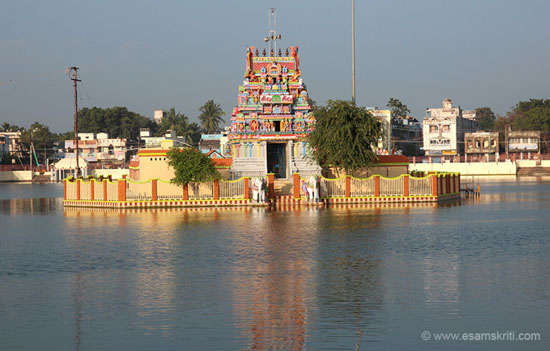 Temple Tank, Thiruvarur temple.
Temple Tank, Thiruvarur temple.
From another
reference in the Siddhantasamuccaya and Siddhantarahasyasara of
Trilocanashiva, we are informed that the author was an ascetic at the
Golakimatha in Svetaraṇya (Thiruvenkadu).
From the
Malkapuram inscription of Kakatiya Rudradeva, we know that Visvesvara-shiva who
was an inhabitant of Gaudadesa and belonged to the Golaki.
Apart from Golaki
Matha, others Shaiva mathas like Mattamayura, Kolla too had considerable
presence over the thought and lives of Shaivas in Tamil Nadu. A Chola inscription
mentions Jnanasiva of the
Lakshadyaya-santana of the Kolla-matha at Varanasi and another mentions
ascetics of the line of Bhiksha-matha at Varanasi who were supported by the
Chola administration.
The presence of Gauda and Madhyadesha Acharyas had considerable impact on various aspects of Temple architecture in Tamil Nadu.
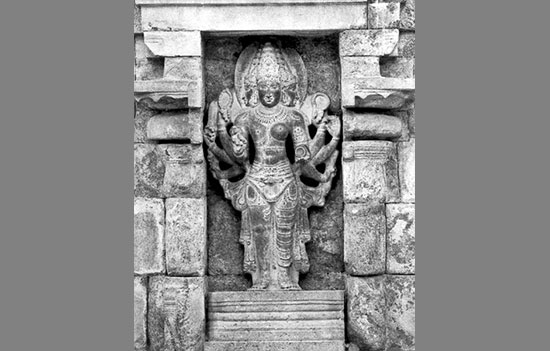 Martanda Bhairava, Darasuram Temple, Kumbakonam, TN. Pic by author.
Martanda Bhairava, Darasuram Temple, Kumbakonam, TN. Pic by author.
In Melkadambur, we
have a Nataraja in worship, which is a Pala Bronze. The presence of four
headed, eight armed Martanadabhairava
(commonly mistaken as Ardhanarishvara due to androgonymous form) in Darasuram
temple is also a concept brought in by the Shakta-Shaiva Acharyas of
Gaudadesha. We find a similar representation in Pala style in Rajshahi museum,
Bangladesh.
A more careful
study would reveal similar patterns of influence of other Shaiva schools from
other parts. Our society did not believe in the
idea of exclusivism.
Rather they were open for noble thoughts from all directions as stated in a Rig
Veda verse.
Conclusion
The growth of any great idea or structure cannot be attributed to a small geography. In keeping up with the great tradition of assimilation of common thoughts, it can be said that the most effective work on Shaiva studies or for that matter any other study will be that which not only transcends the long prevalent limitation of focusing on one artificially constructed territory such as ‘Kashmir Shaivism’ or ‘South Indian Shaivism’ to the exclusion of others, not to mention neglect of the position of these coexisting and often co-functioning traditions in the broader picture.
Also the studies
in theoretical literature of traditions should be complimented by attention on
epigraphic material and ethnographic data. Only by a collective analysis we can
hope to escape to some extent from the limitations set forth by people and
academia with vested interests.
Author Dr Ketu Ramachandrasekhar is the Program Manager at Bharatiya Samskriti Trust, a Non-Profitable Organisation dedicated towards the dissemination of Indic Knowledge Systems and resurgence of the Oldest Living Cultural way of life i.e. Sanatana Dharma. He has his Doctorate in Indian Epistemology and was selected as a Fellow from hundred young scholars across India for Studies in Neuro Aesthetics and Indian Rhetoric by Ministry of Culture, GOI. He was a part of Academic Team of scholars across Europe on discussion of Natya Texts. His expertise in Shaiva Pratyabhijna School is well recognised by scholars of Kashmir Shaivism and he has been a regular contributor to their Journals on the works and contributions of Acharya Abhinavagupta. He has several research articles and books to his credit which includes a detailed study of Abhinayadarpana of Nandikeshvara, Devi Mahatmya and others.
To
read all articles by author
Also read
1. Were
Cholas Hindus
2. Kashi
Tamil Sangam
3. Creating
the Saiva Vaishnav Divide in Tamil Nadu